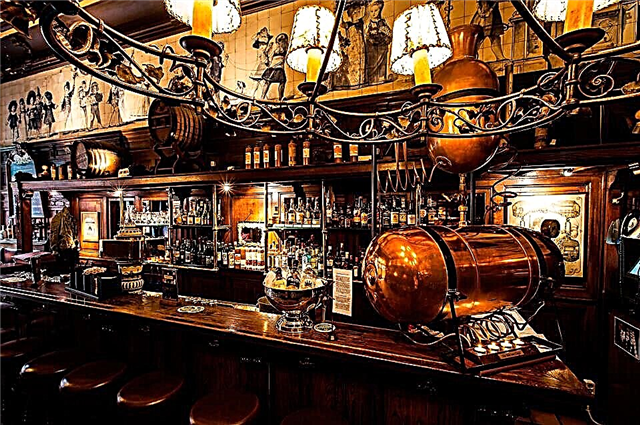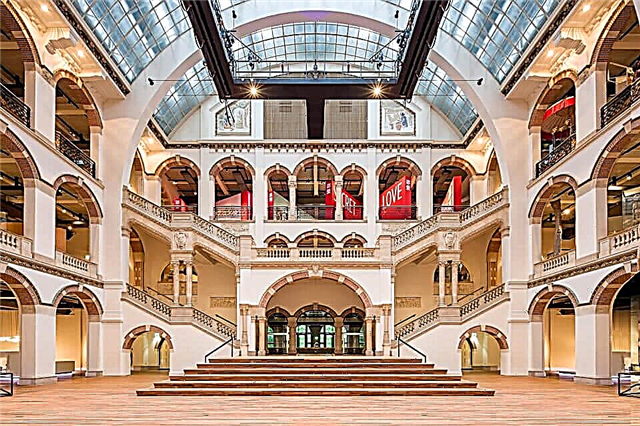The great Russian poet was born in Moscow and died in St. Petersburg. For 37 years of his life, he traveled a lot in Russia. In the first half of the 19th century, the empire was huge, so A. Pushkin passed through the territories that are now owned by independent states - Ukraine, Belarus and Georgia.
By the will of the Russian tsars Alexander I and Nicholas I, the poet was not allowed abroad. He traveled outside the Russian state only once. In 1829, together with the army, Pushkin entered Eastern Anatolia and visited the Turkish city of Arzrum.
Bolshoe Boldino
Article: Bolshoye Boldino - the Pushkin estate in Nizhny Novgorod

View of the Lord's house in the estate of A.S. Pushkin in Bolshoy Boldino
The family estate of the Pushkins, which was owned by the poet's ancestors since the end of the 16th century, is considered one of the most romantic corners of Russia. Alexander Sergeevich did not live in these places, but with pleasure he visited the estate to take a break from the hustle and bustle and gain strength for creativity. Today the old estate has the status of a museum-reserve.
People come to Boldino to admire the beautiful nature of the Volga region, which inspired Pushkin to the most lyrical poems. Tourists can see the old house-museum, the chapel of the Archangel Michael, the Church of the Assumption of the Mother of God, walk along the birch alley, the banks of the ponds and see several monuments to the poet.
Mikhailovskoe
Article: The Mikhailovskoye estate - a family nest and a place of inspiration for the poet

House-Museum of A.S. Pushkin in Mikhailovsky
The popular reserve museum is located in Pskov region... In the noble estate, which for a long time belonged to the Hannibals, the memory of the poet is carefully preserved. The main house was built in the second half of the 18th century. Today the museum of A. Pushkin and his ancestors is open here.
It is very beautiful near the origins of the picturesque Soroti! The estate is surrounded by a well-groomed park and an apple orchard, which is more than 100 years old. In Mikhailovskoye you can see the Nurse's House, linden alleys, century-old spruce trees, dense thickets of hazel, a stone dam, cascades of ponds and Poklonnaya Gorka with a chapel.
State A. Pushkin Museum in Moscow
Article: State Museum of A. Pushkin - memory of the great poet

View of the State Museum of A. Pushkin from st. Prechistenski
One of the largest art museums in Europe is named after the great poet. The spacious halls display a collection of works by foreign brush masters and sculptors from Western Europe from ancient times to the 21st century. The Pushkin Museum was opened in 1961 in a noble estate of the 19th century.
For the 200th anniversary of A. Pushkin, an original glass atrium was erected over the main building and outbuildings. Today, more than 200 thousand exhibits are stored here. Of particular value is a miniature portrait by Vsevolod Yakut, in which Pushkin is depicted as a child. In addition, in the museum you can see the poet's personal belongings, transferred here by Pushkin's descendants.
All-Russian Museum of A. Pushkin in St. Petersburg

Memorial Museum-Apartment of A.S. Pushkin in St. Petersburg
The oldest Pushkin Museum in our country traces its history back to the first museum of the poet, which was created in 1879 at the Tsarskoye Selo Lyceum. Today it is a union of six museums located in the northern capital and the city of Pushkin. They allow you to get a complete picture of the life and creative path of A. Pushkin.
In the former house of the Volkonsky princes, on the Moika, tourists are hosted by a memorial museum-apartment in which the poet spent the last months of his life. A separate exhibition on the second floor is dedicated to the works of Pushkin. The halls display rare lifetime portraits, sketches and manuscripts made by the poet's hand, as well as paintings by his contemporaries. In the city of Pushkin there are two collections - the Museum of the Pushkin Lyceum and the memorial museum at the dacha where the poet lived in 1831.
Museum of A. Pushkin in Bernovo

The manor house in which the A.S. Pushkin in Bernovo
The noble estate of the Wulfs was a place where the poet liked to rest with his friends. Today the original literary museum "Pushkin in Staritsky Uyezd" is open in the old house. Tourists are shown the village “Onegin's study”, the living room, the dining room, the study of the owner of the estate, II Wulf, and the old park of the 18th century.
The Tverskoe village of Bernovo is famous for its colorful holidays - the provincial Wulf Ball, the Pushkin Festival of Poetry, the Russian Round Dance folk song festival and the merry Maslenitsa. Visitors really like the interactive programs "Mermaid Fun" and "Wedding Planner".
Church of the Ascension of the Lord in the Watchmen, at the Nikitsky Gate
Article: The Church of the Ascension of the Lord at the Nikitsky Gate - the church where Pushkin was married

View of the Church of the Ascension of the Lord in the Watchmen, at the Nikitsky gate from Bolshaya Nikitskaya street
Muscovites fondly call the parish church in the center of the city the "Big Ascension". The first temple on this site appeared in 1619. The building in the classicism style, which has survived to this day, was built at the end of the 18th - first half of the 19th century.
When the Ascension Church was not yet completed, it hosted the wedding of Alexander Pushkin and Natalia Goncharova. The solemn ceremony took place in the refectory of the unfinished church on February 18, 1931. The bronze monument to Pushkin and Goncharova, which depicts their wedding, stands on the Arbat, opposite the house where the famous couple lived.
Vyazyoma's estate

House-palace of the estate "Vyazyma"
Beautiful palace and park in Moscow region called the poet's homeland. Just a few kilometers from here, in the small village of Zakharovo, Pushkin spent his childhood. Here he first saw the beauty of Russian nature, was able to admire peasant round dances, heard folk songs and got acquainted with the way of life, customs and everyday life of the provincial nobility of Russia.
Nowadays, both estates have the status of a museum-reserve. On the territory of the memorial complex there are more than 20 historical monuments - a palace with outbuildings, ancient ponds, a belfry of the 16th century, the Transfiguration Church and magnificent parks. A museum dedicated to the poet's childhood has been opened in the restored house of Pushkin's grandmother, Maria Alekseevna Hannibal.
Pushkin grotto in Feodosia

View of the Pushkin grotto in Feodosia
Among sights of Crimeaassociated with the names of great people, an unusual building in the antique style occupies a special place. A closed gazebo from the hot Crimean sun was built in the estate of the mayor of Feodosia S.M. Bronevsky. The poet liked to relax in the coolness of the grotto and wait out the summer heat here.
The architectural monument in Feodosia has been well restored. Tourists can admire the yellow arched entrance and classic columns. The interior space pleases with bright paintings based on the plots of Pushkin's fairy tales, and an old lantern hangs above the swing gates.
Place of Pushkin's last duel

Obelisk at the site of Pushkin's duel
The place where the poet fought with Dantes is in the Primorsky district St. Petersburg... In 1837 the valley of the Black River was located outside the city. The land around was owned by the chef of the Russian emperor F. Miller, who built wooden dachas here and handed them over to wealthy Petersburgers.
One of the reasons why Pushkin and Dantes chose the Black River for the duel was that it was far from the city, and at any time of the year it was possible to get here by road. In 1937, in memory of the tragedy, a granite obelisk with a bronze bas-relief of the poet was erected in the park on the left bank of the Black River.
Museum of A. Pushkin in Gurzuf

View of the A. Pushkin Museum in Gurzuf
The memorial museum of the poet in Crimea occupies a picturesque house, which was built on the South Bank in the 30s of the XIX century for the Governor-General of Novorossiya. Pushkin came to Gurzuf with the family of General N. N. Raevsky. According to the poet himself, it was a happy time.He did not care about anything, swam in the sea for a long time and ate juicy grapes with pleasure.
The museum tells about the Crimean period of the poet's life. Six rooms display materials about the Raevsky family, portraits, drawings and publications of Pushkin during his lifetime. One of the rooms is designed as a memorial study of the famous Pushkin scientist B.V. Tomashevsky, who played a significant role in the creation of the Gurzuf museum.
Pushkin cypress

Pushkin cypress in Gurzuf
For admirers of Pushkin's poetic talent, an old tree on the southern coast of Crimea is a real shrine! A slender cypress was planted in Gurzuf in 1808. During his visit to the Raevskys, the poet repeatedly came to the young tree and even "made friends" with it. Many years after his trip to Crimea, the poet remembered his green "friend" with great warmth.
For more than two centuries, the cypress has grown and matured. Two branches from it were transferred to the Pushkin Memorial Museum in the northern capital and to the grave of Anna Kern. In turn, a young birch tree was planted in Gurzuf, which grew not far from the Pushkin family necropolis in the Pushkin Hills.
Savior Stable Church in St. Petersburg

Church of the Savior Image Not Made by Hands on Konyushennaya Square
The first wooden church in the building of the court Stables department was built at the beginning of the 18th century. The stone church in honor of the Savior Not Made by Hands appeared during the reign of the Russian Empress Elizabeth Petrovna. The house where the Pushkins lived was located nearby - on the Moika embankment.
When the poet died after a duel, it was decided to perform a funeral service for him in a nearby church. The Christian farewell ceremony for Pushkin took place on February 1, 1937. After that, the coffin with the body of the deceased was transported along winter roads to the Holy Dormition Monastery, and the poet was buried next to the ancestral tomb of his parents.
Pushkin spruce

View of the Pushkin spruce in the village of Yazykovo
The legendary tree is a visiting card of the old park in the village of Yazykovo. During his trip to Orenburg, Pushkin collected materials about the Pugachev uprising and drove through these places. In September 1833 he twice stayed at the estate of the Russian poet Nikolai Mikhailovich Yazykov. Unfortunately, the manor house and Pushkin's room burned down in 1922.
A museum telling about the Yazykov brothers, the history of the village and Pushkin's visit here was opened in Yazykovo in 1972. According to legend, Pushkin planted the spruce, but researchers found that in 1833 the tree was already about 60 years old. The sprawling spruce, which the poet could see in the park of the estate, is protected. The old tree has the status of a natural monument of the Ulyanovsk region.
Memorial apartment of A. Pushkin on Arbat

In the house number 53 on Arbat there is a museum “Memorial apartment of A.S. Pushkin "
In the heart of the Russian capital, there is a museum dedicated to the Moscow period of the poet's life. The two-story mansion of the noble family Khitrovo Pushkin brought his young wife, and they spent the first happy months of family life in the house of friends.
More than 50 thousand guests come to the Pushkin Museum on Arbat every year. The exposition takes up the whole house. On the second floor you can see the poet's memorial rooms. They are finished in a graceful Empire style. The floor is decorated with parquet flooring, crystal and bronze chandeliers hang from the ceiling, and heavy elegant curtains hang on the windows.
Svyatogorsk Holy Dormition Monastery

View of the Holy Assumption Cathedral
The poet's grave and the necropolis of his closest relatives are located in the village of Pushkinskie Gory, in an old monastery. The Christian monastery in the Pskov lands was founded in the 1560s by the decree of the Russian Tsar John IV the Terrible. The stone Cathedral of the Assumption rises on the Holy Mountain.
The ancestral necropolis is located at the apse of the monastery church. It is a modest tomb with two stone tombstones and a tablet with the names, surnames and dates of the poet's grandfather, grandmother, parents and younger brother engraved on it.

Grave of A. Pushkin
Pushkin himself is buried in a separate grave, under a beautiful white obelisk.











